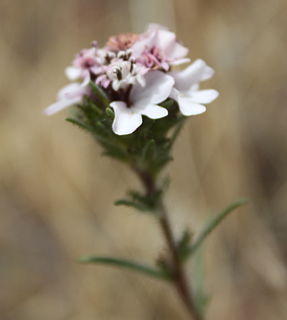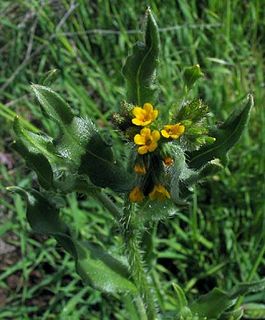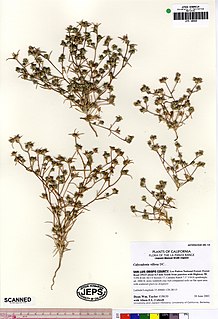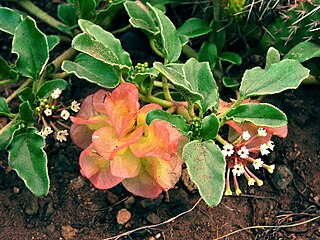| Calycadenia micrantha | |
|---|---|
| Scientific classification | |
| Kingdom: | Plantae |
| (unranked): | Angiosperms |
| (unranked): | Eudicots |
| (unranked): | Asterids |
| Order: | Asterales |
| Family: | Asteraceae |
| Tribe: | Heliantheae |
| Genus: | Calycadenia |
| Species: | C. micrantha |
| Binomial name | |
| Calycadenia micrantha R.L.Carr & G.D.Carr | |
| Synonyms [1] | |
| |
Calycadenia micrantha is an uncommon species of flowering plant in the daisy family known by the common name small-flowered calycadenia. It is endemic to California, where it is known from about 13 occurrences that are widely spread over several counties, including Napa, Siskiyou, Shasta, Mendocino, Trinity, and Monterey Counties, with several populations known in Lake County. [2] [3] [4] It was described to science as a species in 2004. [5] Some specimens of the plant had previously been included within the description of its relative, Calycadenia truncata . [6] The fact that it has been found in relatively far-flung locations suggests it could easily be present in other areas between them and, as a newly classified species, has simply not been reported yet. [3]

Asteraceae or Compositae is a very large and widespread family of flowering plants (Angiospermae).

Endemism is the ecological state of a species being unique to a defined geographic location, such as an island, nation, country or other defined zone, or habitat type; organisms that are indigenous to a place are not endemic to it if they are also found elsewhere. The extreme opposite of endemism is cosmopolitan distribution. An alternative term for a species that is endemic is precinctive, which applies to species that are restricted to a defined geographical area.

California is a state in the Pacific Region of the United States. With 39.6 million residents, California is the most populous U.S. state and the third-largest by area. The state capital is Sacramento. The Greater Los Angeles Area and the San Francisco Bay Area are the nation's second and fifth most populous urban regions, with 18.7 million and 8.8 million residents respectively. Los Angeles is California's most populous city, and the country's second most populous, after New York City. California also has the nation's most populous county, Los Angeles County, and its largest county by area, San Bernardino County. The City and County of San Francisco is both the country's second-most densely populated major city after New York City and the fifth-most densely populated county, behind only four of the five New York City boroughs.
This annual plant produces a slender purplish stem 10 to 50 centimeters tall. The hairy leaves are 2 to 5 centimeters long. The inflorescence is a single flower head or small cluster of heads, each with 1 to 6 three-lobed yellow ray florets. Unlike other Calycadenia species, this plant is self-compatible, or able to fertilize itself. [2]

An inflorescence is a group or cluster of flowers arranged on a stem that is composed of a main branch or a complicated arrangement of branches. Morphologically, it is the modified part of the shoot of seed plants where flowers are formed. The modifications can involve the length and the nature of the internodes and the phyllotaxis, as well as variations in the proportions, compressions, swellings, adnations, connations and reduction of main and secondary axes. Inflorescence can also be defined as the reproductive portion of a plant that bears a cluster of flowers in a specific pattern.

Calycadenia is a genus of flowering plants in the aster family, Asteraceae, known commonly as the western rosinweeds. They are native to California, especially around the Central Valley. The ranges of two species (C. fremontii + C. truncata) do extend north into Oregon.







